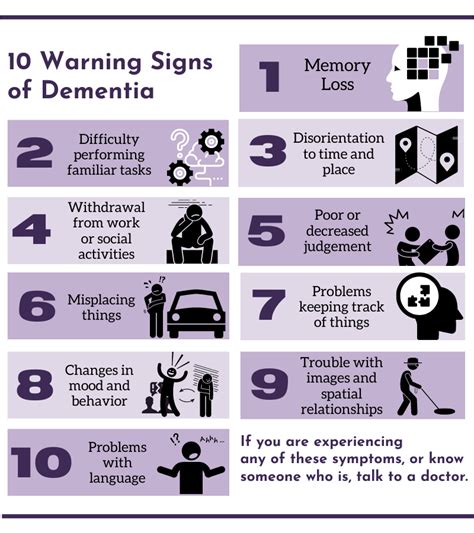
Recognizing the early warning signs of Alzheimer’s disease is crucial for timely diagnosis and intervention, potentially improving the quality of life for those affected and their families. Changes in memory, problem-solving abilities, and mood can be subtle at first, but recognizing these potential indicators is vital for seeking professional evaluation.
Alzheimer’s disease, a progressive and irreversible brain disorder, affects millions worldwide, and early detection is paramount. While there’s currently no cure, identifying the disease in its initial stages allows for interventions that can manage symptoms and improve overall quality of life. The Alzheimer’s Association highlights ten key warning signs that warrant attention: memory loss that disrupts daily life, challenges in planning or solving problems, difficulty completing familiar tasks, confusion with time or place, trouble understanding visual images and spatial relationships, new problems with words in speaking or writing, misplacing things and losing the ability to retrace steps, decreased or poor judgment, withdrawal from work or social activities, and changes in mood and personality.
Ten Key Warning Signs of Alzheimer’s Disease
-
Memory Loss That Disrupts Daily Life: One of the most common early signs of Alzheimer’s is forgetting recently learned information. While occasional memory lapses are normal, those with Alzheimer’s may ask the same questions repeatedly, rely heavily on memory aids (like notes or electronic devices), or struggle to remember important dates or events. It’s not just about forgetting details; it’s about forgetting that the event even happened. “Forgetting recently learned information is one of the most common early signs of Alzheimer’s,” notes the Alzheimer’s Association.
-
Challenges in Planning or Solving Problems: Alzheimer’s can make it difficult to develop and follow a plan or work with numbers. Individuals may have trouble following a familiar recipe, managing monthly bills, or concentrating. These difficulties extend beyond occasional errors; they represent a significant decline in executive function. “Some people may experience changes in their ability to develop and follow a plan or work with numbers,” the Alzheimer’s Association explains.
-
Difficulty Completing Familiar Tasks: Those with Alzheimer’s may find it hard to complete everyday tasks that were once routine. This could include difficulty driving to a familiar location, remembering the rules of a favorite game, or preparing a meal. The issue isn’t lack of knowledge, but an inability to sequence the steps involved. This disorientation with familiar tasks extends to both physical and mental activities.
-
Confusion With Time or Place: Losing track of dates, seasons, and the passage of time is a common symptom. Individuals may forget where they are or how they got there. They may also struggle to understand events that are happening in the future or the past. This disorientation is not simply a momentary lapse but a persistent confusion that impacts daily life. The disorientation can also extend to people. They may forget who they are talking to or what their role is in their life.
-
Trouble Understanding Visual Images and Spatial Relationships: For some, Alzheimer’s can lead to difficulty understanding visual information. This can manifest as problems judging distance, determining color, or reading. These changes aren’t just related to eyesight; they stem from changes in the brain. This can make activities such as driving or navigating familiar environments dangerous.
-
New Problems With Words in Speaking or Writing: People with Alzheimer’s may have trouble finding the right words, struggle to follow or join conversations, or repeat themselves. They might call things by the wrong names or have difficulty understanding what others are saying. The Alzheimer’s Association highlights that individuals may struggle to find “the right word or have trouble following or joining a conversation.”
-
Misplacing Things and Losing the Ability to Retrace Steps: Everyone misplaces items occasionally, but individuals with Alzheimer’s may put things in unusual places and be unable to retrace their steps to find them. They may also accuse others of stealing, particularly as the disease progresses. This behavior is not simply forgetfulness; it reflects a decline in cognitive function.
-
Decreased or Poor Judgment: Alzheimer’s can affect a person’s decision-making abilities. This might manifest as poor financial decisions, a lack of attention to personal hygiene, or wearing inappropriate clothing. This decline in judgment isn’t an isolated incident, but a consistent pattern that can significantly impact their safety and well-being.
-
Withdrawal From Work or Social Activities: As Alzheimer’s progresses, individuals may withdraw from hobbies, social engagements, or work projects. This withdrawal can stem from a combination of factors, including difficulty remembering, changes in mood, and a loss of interest. The Alzheimer’s Association emphasizes that a person with Alzheimer’s might start to remove themselves from “hobbies, social activities, or work projects.”
-
Changes in Mood and Personality: Alzheimer’s can cause significant changes in mood and personality. Individuals may become confused, suspicious, depressed, fearful, or anxious. They may also become easily upset or agitated. These mood swings are not simply personality quirks; they are a direct result of the disease’s impact on the brain. These changes can be particularly distressing for family members and caregivers.
Beyond the Ten Warning Signs: Understanding the Disease
Alzheimer’s disease is the most common cause of dementia, a general term for a decline in mental ability severe enough to interfere with daily life. The disease is characterized by the accumulation of amyloid plaques and tau tangles in the brain, which disrupt communication between neurons and eventually lead to cell death. While the exact cause of Alzheimer’s remains unknown, genetic, lifestyle, and environmental factors are believed to play a role.
Age is the greatest known risk factor for Alzheimer’s, with the risk increasing significantly after age 65. However, early-onset Alzheimer’s, which occurs before age 65, can also occur, although it is less common. Family history is another important risk factor; individuals with a parent or sibling with Alzheimer’s have a higher risk of developing the disease themselves.
Research suggests that certain lifestyle factors may also influence the risk of Alzheimer’s. These include maintaining a healthy diet, engaging in regular physical activity, staying mentally active, and managing cardiovascular risk factors such as high blood pressure, high cholesterol, and diabetes. While these lifestyle changes cannot guarantee prevention, they may help reduce the risk and promote overall brain health.
The Importance of Early Diagnosis
Early diagnosis of Alzheimer’s is crucial for several reasons. First, it allows individuals and their families to plan for the future, including making financial and legal arrangements, considering long-term care options, and communicating their wishes. Second, it enables access to available treatments that can help manage symptoms and improve quality of life. While these treatments cannot cure Alzheimer’s, they can help slow the progression of the disease and alleviate some of the cognitive and behavioral symptoms. Third, early diagnosis allows individuals to participate in clinical trials and research studies, which may contribute to the development of new and more effective treatments. Finally, early diagnosis provides an opportunity for individuals and families to connect with support services and resources, such as counseling, support groups, and respite care.
“Early diagnosis allows individuals and families to plan for the future and access available treatments,” states the Alzheimer’s Association, reinforcing the importance of proactive healthcare.
Diagnosis and Treatment
Diagnosing Alzheimer’s disease typically involves a comprehensive medical evaluation, including a review of medical history, a physical examination, neurological and mental status assessments, and brain imaging tests such as MRI or CT scans. These tests can help rule out other possible causes of dementia and identify characteristic changes in the brain associated with Alzheimer’s. In some cases, a lumbar puncture may be performed to analyze cerebrospinal fluid for biomarkers of Alzheimer’s.
Currently, there is no cure for Alzheimer’s disease, but several medications are available to help manage symptoms. Cholinesterase inhibitors, such as donepezil (Aricept), rivastigmine (Exelon), and galantamine (Razadyne), can help improve cognitive function by increasing the levels of acetylcholine, a neurotransmitter that is important for memory and learning. Memantine (Namenda) is another medication that can help improve cognitive function by regulating the activity of glutamate, another neurotransmitter involved in learning and memory. In addition to medications, non-pharmacological interventions, such as cognitive training, physical activity, and social engagement, can also help improve cognitive function and quality of life.
Living With Alzheimer’s Disease
Living with Alzheimer’s disease can be challenging for both individuals and their families. As the disease progresses, individuals may require increasing levels of care and support. Family caregivers often face significant emotional, physical, and financial burdens. It is important for caregivers to prioritize their own health and well-being and to seek support from family, friends, and community resources.
Support groups can provide a valuable source of emotional support and practical advice for caregivers. Respite care, which provides temporary relief for caregivers, can help prevent burnout and improve overall well-being. Assistive devices and home modifications can help individuals with Alzheimer’s maintain their independence and safety. Communication strategies, such as speaking slowly and clearly, using simple language, and providing visual cues, can help improve communication and reduce frustration.
“Living with Alzheimer’s disease can be challenging for both individuals and their families,” underscores the Alzheimer’s Association, emphasizing the need for comprehensive support.
Research and Future Directions
Ongoing research is focused on developing new and more effective treatments for Alzheimer’s disease, as well as identifying strategies for prevention. Researchers are exploring a variety of approaches, including developing drugs that target amyloid plaques and tau tangles, identifying genetic risk factors, and investigating the role of inflammation and other biological processes in the development of the disease. Clinical trials are essential for evaluating the safety and efficacy of new treatments. Individuals interested in participating in clinical trials can contact the Alzheimer’s Association or the National Institute on Aging for more information.
The development of biomarkers for Alzheimer’s disease is another important area of research. Biomarkers are measurable indicators of a disease or condition that can be used to diagnose the disease, monitor its progression, and predict its response to treatment. Biomarkers for Alzheimer’s disease include amyloid plaques and tau tangles in the brain, as well as proteins and other substances in cerebrospinal fluid and blood.
Promising Developments
Recent breakthroughs in Alzheimer’s research have brought renewed hope for the future. The FDA’s accelerated approval of aducanumab (Aduhelm) and lecanemab (Leqembi), monoclonal antibodies that target amyloid plaques, represents a significant step forward in the treatment of Alzheimer’s disease. While these drugs have shown promise in slowing cognitive decline in some individuals, they are not a cure and are associated with potential side effects. Further research is needed to fully understand the long-term benefits and risks of these treatments.
Hope for the Future
While Alzheimer’s disease remains a significant public health challenge, ongoing research and increased awareness are leading to progress in diagnosis, treatment, and prevention. By recognizing the early warning signs, seeking early diagnosis, and engaging in healthy lifestyle choices, individuals can take steps to reduce their risk and improve their quality of life. Continued investment in research is essential for developing new and more effective treatments and ultimately finding a cure for this devastating disease.
Frequently Asked Questions (FAQ)
Q1: What is the difference between normal age-related memory loss and Alzheimer’s disease?
A: Normal age-related memory loss involves occasional forgetfulness, such as misplacing keys or forgetting a name, but does not significantly disrupt daily life. Alzheimer’s disease, on the other hand, involves persistent and progressive memory loss that interferes with everyday activities, such as difficulty remembering recently learned information, asking the same questions repeatedly, or getting lost in familiar places. According to the Alzheimer’s Association, “Forgetting recently learned information is one of the most common early signs of Alzheimer’s,” which distinguishes it from typical age-related memory lapses. Additionally, Alzheimer’s involves decline in other cognitive domains beyond memory.
Q2: Can Alzheimer’s disease be prevented?
A: While there is no guaranteed way to prevent Alzheimer’s disease, research suggests that certain lifestyle factors may help reduce the risk. These include maintaining a healthy diet, engaging in regular physical activity, staying mentally active, and managing cardiovascular risk factors such as high blood pressure, high cholesterol, and diabetes. The Alzheimer’s Association emphasizes that “what’s good for the heart is good for the brain,” highlighting the importance of cardiovascular health in reducing Alzheimer’s risk. More research is needed to determine the precise role of these lifestyle factors in preventing Alzheimer’s.
Q3: Is there a cure for Alzheimer’s disease?
A: Currently, there is no cure for Alzheimer’s disease. However, several medications are available to help manage symptoms and improve quality of life. Cholinesterase inhibitors, such as donepezil (Aricept), rivastigmine (Exelon), and galantamine (Razadyne), can help improve cognitive function by increasing the levels of acetylcholine, a neurotransmitter that is important for memory and learning. Memantine (Namenda) is another medication that can help improve cognitive function by regulating the activity of glutamate, another neurotransmitter involved in learning and memory. The Alzheimer’s Association notes that these medications “can help lessen cognitive symptoms, although they don’t stop the underlying damage to the brain.” Research continues to explore potential disease-modifying therapies.
Q4: What should I do if I suspect that I or a loved one has Alzheimer’s disease?
A: If you suspect that you or a loved one has Alzheimer’s disease, it is important to consult a doctor as soon as possible. The doctor can conduct a comprehensive medical evaluation to determine the cause of the symptoms and recommend appropriate treatment and support. Early diagnosis is crucial for several reasons, including allowing individuals and families to plan for the future, accessing available treatments, and participating in clinical trials. The Alzheimer’s Association recommends “seeing a doctor for a thorough evaluation” if you notice any of the warning signs of Alzheimer’s.
Q5: What resources are available for people with Alzheimer’s disease and their families?
A: A variety of resources are available for people with Alzheimer’s disease and their families, including support groups, counseling services, respite care, and educational programs. The Alzheimer’s Association is a leading resource for information and support, offering a helpline, website, and local chapters throughout the country. Government agencies, such as the National Institute on Aging and the Centers for Disease Control and Prevention, also provide information and resources on Alzheimer’s disease. It’s important for caregivers to seek support, as “caring for someone with Alzheimer’s can be emotionally and physically draining,” according to the Alzheimer’s Association.









